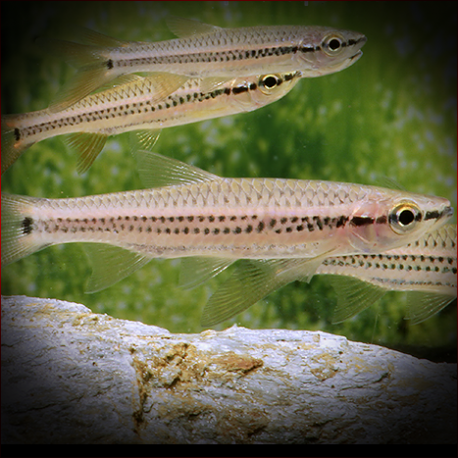More info
Datasheet
| Minimum Tank Size | 255 litres / 67.36 US gallons |
| Maximum Size | 13.2cm / 5.20inches |
| Temperature | 22°C / 71.60°F - 25°C / 77.00°F |
| Hardness | 1-12ºdH |
| pH | 5.0-7.5 |
Behaviour:
This Porthole Rasbora species thrives in peaceful communities alongside Southeast Asian/Indian species like similarly-sized Rasbora, Puntius, botiid loaches, and Trichogaster gouramis. It displays its best colors in the presence of at least six conspecifics, resulting in a more natural display and reduced nervousness. In a biotope aquarium setup, it can coexist with other Malaysian/Bornean blackwater species such as Puntius lineatus, P. pentazona, Trigonopoma gracile, T. pauciperforatum, Rasbora caudimaculata, and Pangio loaches.
Feeding and Diet:
These Rasboras primarily feed on aquatic and terrestrial invertebrates in the wild. In captivity, they readily consume live and frozen foods like bloodworms, Daphnia, and Artemia, along with high-quality dried flakes and granules. Offering a varied diet ensures optimal coloration and overall health.
Reproduction & Dimorphism:
Breeding Porthole Rasboras is feasible through egg scattering, as they exhibit no parental care. Creating a dimly lit, densely planted tank encourages spawning. Once conditioned adults spawn, transferring them to a separate breeding container with appropriate conditions enhances fry survival rates. Mature females appear rounder and slightly larger than males.
Habitat and Distribution:
Inhabiting blackwater streams and rivers in ancient forest peat swamps, Porthole Rasboras prefer soft, acidic water with a pH ranging from 5.0 to 7.5 and temperatures between 22-25°C. Their distribution spans Peninsular Malaysia, Borneo, and Sumatra, including specific locations like peat swamps in Selangor state, streams in Pahang state, and rivers in Sarawak state in Borneo.
Aquarium Setup:
To recreate their natural habitat, provide a well-planted tank with a soft, sandy substrate, driftwood, and dried leaf litter. Mimicking blackwater conditions with tannin-stained water, using aquarium-safe peat or genuine peat fiber enhances their coloration. Maintaining dim lighting and adding suitable plants like Microsorum pteropus and Cryptocorynes, along with floating vegetation, creates an ideal environment. Proper water maintenance is crucial.
General Description:
Known for its elegance and peaceful demeanor, the Porthole Rasbora is a gregarious species that displays vibrant colors in the presence of conspecifics. Distinguished by a dark lateral stripe running along its body, this species belongs to the family Cyprinidae and reaches a maximum size of 13.2cm. The species, Rasbora Cephalotaenia, is a captivating addition to larger community aquariums.

